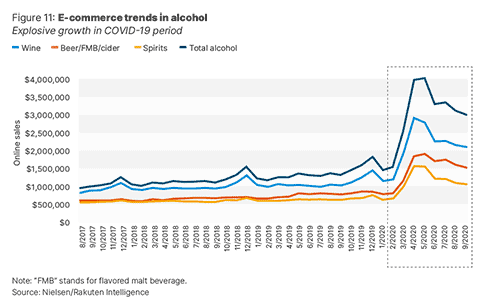
Distributing wine and spirits is a delicate and demanding operation. Warehouses are expected to process, store, and fulfill a massive catalog of products to a wide portfolio of clients, all with their own special requests. An operations employee in a distribution warehouse has their work cut out for them, as the constant supply and demand fluctuates depending on a multitude of factors like seasonality, geography, product timing, and more.
Investing in an automated wine and spirits warehouse solution can absolutely support operations in more ways than one, moving product safely, quickly, and where it needs to be. Evaluating current warehouse operations is certainly a smart move, especially considering the status of the wine and spirits industry now, and in the near future.

“We believe there is a permanent consumer shift to more online purchases of wine, which will expand with the coming of age of millennial consumers.”
To help in your evaluation, here are 7 cost-saving and effective warehouse solutions that’ll support your wine and spirits distribution operations.
1. Labeling and shipping costs
Correct labeling of alcoholic beverages is not only important for delivery operations but needed for state alcohol regulations and the associated shipping costs. Recurring mislabeling can incur hefty fees and make distribution a headache. Automated print and apply systems can streamline these processes and lower error rates and are relatively easy to add to a warehouse operation. Labeling machines produce the correct shipping information and apply the label by stamping it as the carton passes by, without the need to pick up or stop the product.
2. Warehouse Management System (WMS)
The ability to have complete visibility of your warehouse inventory at all times is paramount to operating effectively. A warehouse management system (or WMS) stores vital information such as alcohol percentage, storage location, best-by dates for rotation, and a multitude of SKU data for ordering. A WMS can even offer a best shipping rate selector and presents data with correct state alcohol regulations applied.
Besides being a source of important product information, a WMS can apply that information within your warehouse operations. For example, if the wrong item is picked and placed on an outbound conveyor, the scan tower will read the label and the WMS will recognize it is in the wrong batch, stopping that section of conveyor and sounding an alarm for a worker to remove the incorrect item.
3. Direct to consumer wine and spirits shipping
The prevalence of direct-to-consumer (D2C) wine and spirits services continue to grow, with wine clubs, subscription boxes, alcoholic beverage delivery, and other flexible solutions becoming more common with consumers. If you are looking to expand your consumer base, investing in a D2C approach early can prove proliferous in the near future. Order fulfillment automation solutions are versatile enough to fit within any step of your operation, ranging from automatic item picking to shipping label application. The importance of effective packing operations to avoid breakage should also be considered. Careful selection of package erecting, sealing, and void-filling machines are all a part of integrating a wine or liquor order fulfillment warehouse process.
4. Gapping and breakage reduction
An unfortunate truth of the wine and spirits distribution industry is that product breakage can and will happen. All you can do in your warehouse is minimize it. An effective method of doing so is using a zero-pressure accumulation conveyor. These gravity conveyors do no allow products to touch each other, using an array of sensors to properly gap infeeding operations, and stopping when the accumulation zone is full.
To increase product safety, a herringbone (canted rollers) design can be used to avoid product from making contact with side railing and guards. For even more stability, a cascade release function can be implemented, which staggers conveyor zones as product begins to move. This provides a small gap between each product when operations start and stop.
5. Storage solutions for reserves and limited run beverages
Managing a fully stocked wine and spirit storage can get complicated when limited run products and desirables vintages are concerned. This creates a need for both short-term and long-term pallet storage. Automation in the form of an ASRS (automatic storage and retrieval system) can rapidly retrieve pallets that need to be distributed or store long-term inventory in the most optimal spot within a racking system. An ASRS uses a crane attached to a horizontal and vertical track, scaling the racking structure, and using extendable forks to handle pallets. The operator terminal provides information on what product is stored where, and the ASRS operates when a retrieve or store command is inputted.
6. Cross-docking for quick sortation and delivery of non-stored items
Cross-docking is a warehouse operation that processes items, sorts them to the correct location, and sends them right back out for transportation. Packages are introduced and sent to their destination route quickly and efficiently without storing or spending more than 24 hours in a cross-docking operation.
For high-volume wine and spirit warehouses, this method provides extremely effective in getting product to stores or delivering to customers.
7. Flexibility in handling a variety of packaging types
Wine and spirit companies are innovating in specialty packaging types to attract customers in a constantly competitive product environment. Coupled with the growing sales of cannabis, companies are investing a significant amount in resources to ensure their product stands out.
Wine and spirits warehouse distribution operations must be dynamic enough to maintain current clients and attract new ones who have packaging designs that call for special handling. Automation systems, such as conveyors, are manufactured in different dimensions and applications and can be engineered in a warehouse layout to accommodate cartons of varying sizes and fragility.
Century Systems has extensive experience in integrating warehouse automation systems in the wine and spirits material handling industry. View the video below on a system we engineered and integrated with Fedway Associates.



